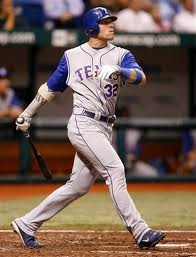
Josh Hamilton is this season's oWAR leader.
Of the Bench’s series on rethinking the offensive lineup continues today with a look at Offensive Wins Above Replacement.
oWAR
Offensive Wins Above Replacement is very similar to regular WAR, except for the fact that it doesn’t take into account defensive metrics. All WAR stats compare a player to a generic “replacement level” player. A replacement level player is defined as a typical minor league/bench level guy. Basically, WAR creates a level playing field upon which to judge exactly how good Albert Pujols is relative to Ronnie Cedeno and how much each player means to the success of their team. oWAR isolates offensive ability and could be a good way to organize a lineup. The best hitters have the highest oWAR and by grouping those guys at the top of the order, we can hopefully maximize abs for the team’s best hitters.
Philadelphia Phillies:
- Carlos Ruiz (2.0)
- Hunter Pence (1.0)
- Shane Victorino (1.0)
- Placido Polanco (.1)
- Ty Wigginton (0.0)
- John Mayberry Jr. (-.1)
- Jimmy Rollins (-.2)
- Freddy Galvis (-.2)
- Pitcher
Texas Rangers:
- Josh Hamilton (3.1)
- Elvis Andrus (1.4)
- Adrian Beltre (1.4)
- Ian Kinsler (1.2)
- Mike Napoli (.9)
- Mitch Moreland (.7)
- Nelson Cruz ( .6)
- David Murphy (.5)
- Michael Young (.1)
Pros: The biggest pro that is clearly obvious from our sample lineups is that oWAR cuts through all the peripherals and isolates the batters that are truly productive and good at what they do. Its a more complicated stat than AVG or OBP and it takes more into into account actual offensive production. In that way, oWAR groups the best hitters at the top of the order where they can get the most abs and sticks the worst hitters at the bottom where they will get the fewest chances.
Cons: oWAR rates hitters based upon their individual performance and, much like the other stats we’ve looked at in this series, does not take the rest of the team into account. So, Josh Hamilton at the top of the lineup makes sense from an individual standpoint, clearly, getting Hamilton the most possible plate appearances makes great sense. However, Hamilton hitting leadoff would deny him a ton of RBI opportunities, or if you prefer, abs with runners on base. This is exacerbated by the fact that even after the first inning, the batters hitting in front of the good-hitting group at the top are bad hitters. By placing your best hitter first, and thereby closer to the group of poor hitters at the bottom of the order, you make the issue even worse. Additionally, speed is not really a consideration here, at least not a major one. By looking at the Phillies sample lineup, we can see the result. Carlos Ruiz, the catcher, is hitting directly ahead of Hunter Pence and Shane Victorino, two of Philly’s speedier players.
Final Thoughts and Verdict: Overall, I think oWAR is a great way to organize a lineup. oWAR is an advanced sabermetric stat that takes a ton into account and paints a very effective picture of a hitter. By making your lineup based on this stat, you can effectively get your best hitters to the plate as much as possible, which, we’ve determined gives you the best chance of winning, which is the goal. oWAR would be a more effective way to arranged batting order if it wasn’t strictly followed. I the Phillies case, the bottom of the order is a bit of a black hole. If someone like Jimmy Rollins, who is a former MVP, is placed nearer to the top of the order then the rest of the currently good hitters could be shifted down, lessening the clump of poor oWAR guys near the bottom.
-Max Frankel















